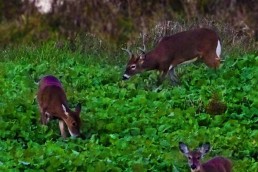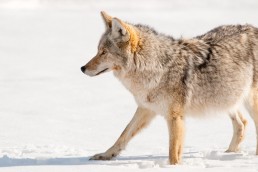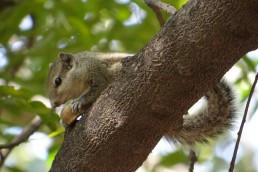The Candy Man Can: Late-summer Annuals for Attracting Whitetails
SHARE THIS POST
by Todd Amenrud
It’s time to get those late-summer food plot seeds in the ground. If you have enough ground to devote to your plot program, most managers would agree that a well-diversified program with an assortment of plants to offer your herd is the way to go. You want to give the deer what they need, regardless of the season or conditions. Some of the plants you choose are likely perennials, but most sow perennials during the spring in the North. For the best in attraction during the hunting season, though, it’s hard to beat a food plot full of luscious late-summer annuals.
Annuals are typically easy to plant, and since they are planted late summer into the fall, the summer weed cycle should be mostly over. The two primary late-summer plantings are cereal grains and brassicas. Here in the Upper Midwest, brassicas should be planted during July through early August with cereals planted from late July (Upper North around the Canadian border) through mid- to late August farther south (Iowa, Illinois, etc.).
A common progression during the hunting season would be to see your herd switch from legumes (perennials like clover or alfalfa, or annuals like soybeans or cowpeas) to cereal grains (oats, wheat or triticale) or to brassicas (like radishes, turnips, rape and kale). With these three types of plantings, you should have a palatable food choice throughout most of the hunting season or until each type of food runs out. Different crops will dramatically extend the palatability time frame of your plot.
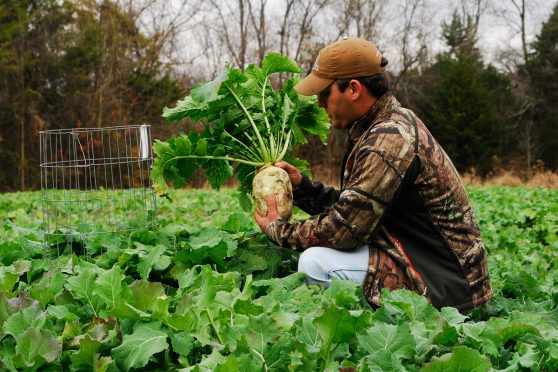
Some brassicas like radishes and turnips will grow large root bulbs or tubers that whitetail relish along with the plant’s green tops. Photo: Jesse Raley
To take that “variety approach” a step further, within every type of crop, plant a different assortment of each so it will also extend the amount of time your plot will remain attractive. This is especially so for brassicas, my favorite food-plot plant.
From my experience, the deer will attack radishes first. Whitetails will lay siege to the green tops first then finish by devouring every bit of the long-root tubers. These aren’t your auntie’s dinner radishes, but large tubers that resemble a huge, white carrot, rather than our more familiar small, round, red and white radishes. My favorite blend is BioLogic’s Deer Radish. This is not just my preferred for brassica planting, it’s my favorite blend, period. From my experience, the deer will begin eating these radishes around mid- to late September until they’re gone.
Next, your whitetails will typically set their sights on various turnips and beets. While sugar beets are actually in a different plant family and are not a brassica, they are very similar. Just like turnips, cold temperatures cause the plant’s high levels of starch to convert to sugar. I usually see them hit these plants after the radishes and I use them for attraction for November and December. My favorite blend is Winter Bulbs & Sugar Beets and, just like the radishes, they will consume the entire plant; first they’ll eat the greens and then the root bulbs. The radishes are easier for them to pull out of the ground and consume so you’ll see partially eaten turnips or they’ll scoop out the top and inside of the turnip or beet so it looks like a “beet bowl” left in the soil.
Lastly, they tend to hit rape, canola and kale after the radishes, turnips and beets. These last three brassica types do not produce large root bulbs or tubers like radishes, beets or turnips, but they produce an amazing yield of green forage. I use these last three brassica types more as “winter nutrition” than “hunting-time attraction.” Maximum results produce a yield of more succulent, nutritious forage than any other planting I’ve ever seen. While they certainly may hit these brassicas as soon as cold temperatures convert the plants’ huge green tops to become sweet, if you have radishes and turnips also planted they’ll typically consume rape after the other two brassica types. Kale is especially cold hardy. This plant’s large leaves will stay green and attractive long into the winter even if covered by several feet of snow.
Remember that the time frame I’m suggesting for these to be their most attractive is just a guess. It can vary from year to year and region to region. As an example, in the “big woods” where there isn’t a lot of agriculture or other foods to back up your food plots, they may eat any of these as fast as they come out of the ground. Or, if we have an unseasonably warm fall, it may take the brassicas longer to develop their sugars, pushing back the entire “attraction calendar.”
Are you enjoying this post?
You can be among the first to get the latest info on where to go, what to use and how to use it!
The other great thing about brassicas is not only that are they the best attraction, they are also without a doubt the absolute best nutrition you can provide for your herd. With an average crude protein content of 32 to 38 percent (depending on the cultivar and stage of growth) and a TDN of over 80 percent (Total Digestible Nutrients), I believe they are the best “deer food” God has ever created.
More often than not, I plant my cereals and brassicas separately, for several reasons. However, if a manager wants a fast, simple, one-and-done plot, a blend of cereals and brassicas (sometimes other plants) together may be your ticket. Blends like Full Draw, Last Bite, Green Patch, or Winter Grass Plus provide brassicas mixed with cereal grains. An annual or bi-annual clover is sometimes added to provide extra nutrition or a flush of nutritious forage reemerging after dormancy the following spring.
I haven’t mentioned much about the spring-planted crops that are also very attractive to the whitetails like corn, buckwheat or clover. The other late-summer planted annuals like winter peas, which are amazingly appealing to whitetails, but are probably too attractive, should be recognized too. With winter peas, you need to plant enough to overwhelm the amount of mouths you’re feeding or they’ll promptly wipe you out.
One important thing to mention is that brassicas can also be planted with perennials. Normally here in the North we traditionally plant our perennials during the spring, but it is possible to also plant them during late summer. If I do, I will most often plant them with annual brassicas. Blends like Perfect Plot or Premium Perennial are my go-to products for this. You just need to make certain when planted here in this region that you give the perennials 50 to 60 days of growth so they can establish their root systems, which will ensure their survival and reemergence after winter dormancy. Since obviously the brassicas are annuals and won’t come back, I suggest you over-seed with a pure perennial the following spring to fill in any spaces vacated by the annual brassicas from the past fall.
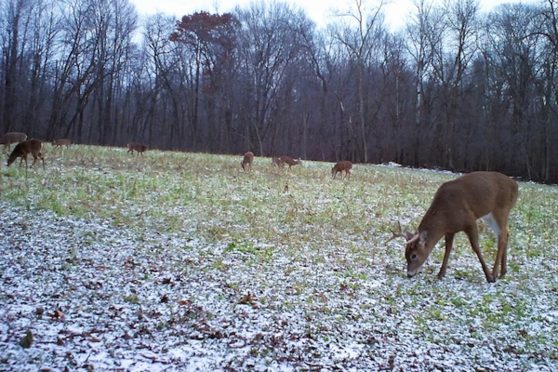
Brassicas can be attractive all the way through the hunting season and certain varieties will remain attractive late into the winter. Photo: Dave Medvecky
Variety in a food plot program is important even though I’ve listed brassicas are my favorite plot crop. But all of the plants mentioned are great choices for a food plot. Remember that they are eaten at different times or under different conditions, which is exactly why it’s smart to plant a variety if you have enough acreage to devote. MWO
MWO
SHARE THIS POST
Did you enjoy this post?
You can be among the first to get the latest info on where to go, what to use and how to use it!
Dave Mull
Dave Mull of Paw Paw, Mich. has spent his career communicating the outdoors experience and runs Inner Viking Media. He enjoys kayak fishing for anything that swims in the lakes and rivers of the Midwest and beyond, and even uses his MirroCraft, from time to time. Available for seminars.
